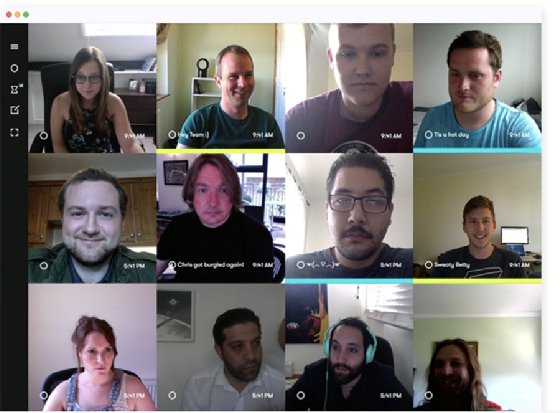
kentoh - Fotolia
Remote team tech Sneek keeps co-workers in view
Sneek, a remote team platform, uses frequently updated photographs of remote workers to connect co-workers together.
Sneek doesn't fit neatly into any remote technology category. The tool seems like employee monitoring software because, throughout the workday, a webcam snaps photos of employees at regular intervals to update a customer's "wall of faces." But Sneek is more like an online chat platform -- with a visual element.
Analog Republic Ltd., which designed the tool, said Sneek is meant for small, dispersed teams. The employee photographs displayed can be automated to update every one to five minutes; photos are not saved. Users can also use a static photo or choose to pixelate themselves so others can't see them clearly. The tool enables co-workers to see who is online and what their availability is, and to quickly connect and engage. All they have to do to start a video chat is to click on a co-worker's face.
Del Currie, co-founder of the London-based firm, argues that the remote team platform has an entirely different purpose from monitoring technology. In an interview, edited for clarity, Currie explains the company's approach.
What types of companies are using this technology?
 Del Currie
Del Currie
Del Currie: The majority of our customers are small digital agencies. A large corporate firm might use it for an internal project. The average is 10 users on a team who are spread out in different locations, potentially different time zones. A large team would be 20 people.
Why not continuous video streaming?
Currie: Bandwidth and cost. And continuous video gets annoying after a while. A lot of the time, Sneek will be in the background anyway on your screen.
You compare the remote work platform to working in an office. But seeing a wall of co-workers on your screen, throughout the workday, feels a little more in your face. Does it make people uncomfortable?
Currie: It's not for everybody. If you are not a social person, it probably is not the right app for your company to be using. You are better off just messaging and using Zoom when you need to have a call. Ours is very specific. It's really for groups of friends.

This then is designed for a culture that can work well together. Is this the case?
Currie: It is. We don't want people to use Sneek to spy on their employees. We know who those [prospective users] are when they come in and try it out. They don't stick around. A picture that updates every five minutes is practically useless to them. If they really want to spy on employees, they will get screen recorders and keystroke trackers.
If someone believes that Sneek could be a good way to track remote team workers, why is that thinking a mistake?
Currie: It takes a special person to be a remote worker. When office people work from home, they treat it as a snow day. Remote workers work remotely because they love that lifestyle. They don't worry about watching employees. That's very much the corporate world: They don't trust anybody they hire. The remote community is very much about trust. If you've got someone at home all the time, you have to trust them when you hire them.
There may be employees on a team that just feel that this tool is not for them. How do you deal with that?
Currie: They end up not using it. You can't force things like this on people who don't want to do it in this day and age. That's a rare occurrence because it's not our client base.
What impact does this have on office dynamics and productivity?
Currie: No. 1, it is massive time savings for us because of that instant connectivity between people. With Slack, Zoom or Skype, you have to message: 'Hey, are you free for a quick chat?' I can just look at Sneek and see if someone's not there and know to just wait for them to come back. Also, we see each other all day, so our conversations are much shorter. The No. 2 benefit is the mental health of your employees to not feel isolated and have that element of human contact.
Is there respect for boundaries?
Currie: Sneek doesn't force you to be on there. Pixelate yourself if you're not looking good.
Do you feel that what you're doing is misunderstood?
Currie: One hundred percent. We love remote work, remote work culture. And part of that is staying connected with your team and having that social human aspect. We don't monitor anybody. We create a social environment for remote teams to connect to each other.







